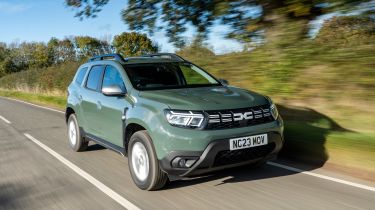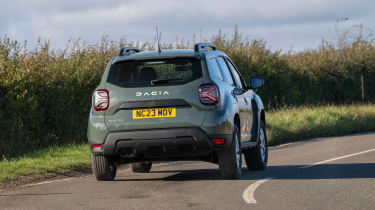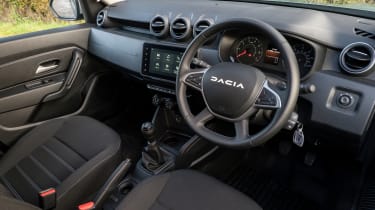New Dacia Duster Commercial 2023 review: a cheap, but extremely capable small van
Dacia’s no-frills approach to budget motoring lends itself to the commercial vehicle genre, making the Duster Commercial an appealing option
Verdict
If you’re in need of a cheap van with plenty of off-road ability, the Dacia Duster Commercial is almost your only choice. Dacia’s no-frills approach to budget motoring lends itself to the commercial vehicle genre very well and the van version of the Duster is an appealing, if somewhat niche, offering.
An all-new Duster is coming soon and with it we eventually expect to see a revitalised version of the Duster Commercial - an SUV-based van that offers something different to the typical cohort of small vans like the Renault Kangoo and Ford Transit Connect. For now, the Duster Commercial you can buy is based on the Mk2 Duster and that’s what we’re driving here.
The Duster Commercial’s closest rival is probably the Suzuki Jimny Commercial - a fellow small SUV that has its rear seats removed and a metal mesh bulkhead. Other offerings that follow this formula include the Land Rover Defender Hardtop and Land Cruiser Commercial, although these cost significantly more than the Duster.
Speaking of cost, Dacia prices the Commercial higher than its equivalent Duster SUV trim levels, so as you’d expect the Commercial model only makes sense as a work vehicle. Two trim levels are available, entry-level Essential and top-spec Expression (the Commercial doesn’t get the Duster passenger car’s more lavish Journey and Extreme trim levels).
Used - available now

2023 Audi
e-tron
15,498 milesAutomaticElectric
Cash £23,158
2023 Audi
e-tron
29,621 milesAutomaticElectric
Cash £21,738
2025 Toyota
Yaris Cross
59,684 milesAutomaticPetrol1.5L
Cash £16,058
2022 Volvo
XC40
48,424 milesAutomaticPetrol1.5L
Cash £19,705The Duster Commercial in Essential trim costs from just over £19,000 whereas our Expression version is priced at just over £22,000 - making it more expensive than the Jimny Commercial but cheaper than most small vans like the Transit Connect, Renault Kangoo and Vauxhall Combo - which have better carrying capacities but lack the Duster’s off-road ability.
Many budget-conscious businesses will be drawn to the cheapest version of the Duster and this is the one we think makes the most sense. The Essential, as the name suggests, focuses on the essentials and there’s not much in terms of exterior flair inside or out, but it retains a certain workhorse charm to it. There’s still electric windows (front only), emergency brake assist, rear parking sensors, cruise control, hill start assist, automatic headlights and a leather steering wheel. The Expression trim level adds a rear parking camera, 16-inch alloy wheels plus body-coloured wing mirrors and door handles.
The interior is clad mostly in hard plastics which should stand up to any worksite. The eight-inch touchscreen is easy to navigate and quick too, plus there’s Apple CarPlay and Android Auto wired connectivity. While the physical climate control dials beneath the screen are handy, the volume buttons integrated into the side of the screen aren’t great - thankfully there are some physical volume switches on a stalk behind the steering wheel.
The Essential only gets the choice of two powertrains - a 1.0-litre turbocharged three-cylinder with 90bhp and two-wheel drive or a 1.5-litre four-cylinder diesel with 115bhp and four-wheel drive. The Expression has that diesel engine also available with two-wheel drive plus a 1.3-litre turbocharged four-cylinder petrol with 150bhp and an automatic gearbox - all the other Duster Commercials come with a manual.
The Duster Commercial Expression we’re testing is fitted with the 1.5-litre diesel with two-wheel drive. Dacia quotes an efficiency figure of 58.9mpg combined but we managed to easily achieve over 66mpg on a long motorway run, with some extra stop/start town driving thrown in, this only dropped to 61mpg so it’s a frugal thing. Make use of the 550kg payload capacity and you’ll find that this figure will drop further, however.
Thankfully, Dacia has retained the use of the rear doors although the positioning of the metal bulkhead means only small items can be chucked into the load area from there. From the rear the loading lip is obviously higher than a compact van, but a flat plastic floor all the way to the bulkhead means sliding heavy items in is no problem. The two-wheel drive Commercial comes with 1,623 litres of boot space and the four-wheel drive model decreases this to 1,559 litres - the same as the Duster SUV with its rear seats folded down.
To drive, the Duster Commercial feels pretty much the same as the SUV. There’s a smidge more road noise behind you with the lack of rear seats but overall it’s a nice place to rack up the miles and certainly just as comfortable as any traditional van of this size. We had an issue with the driver’s seat feeling a bit loose and are currently awaiting a diagnosis from Dacia on this - it may have been a one-off fault. The diesel engine isn’t the most refined, but it’s neither gruff nor clattery. With 115bhp 260Nm of torque there’s plenty of shove here.
The main reason why you’d pick the Duster Commercial over the usual compact van alternative is the Dacia’s off-road ability. While the two-wheel drive will still give you excellent ground clearance we’d recommend going for the four-wheel drive option (and more importantly a set of off-road tyres) to really make the most of the Duster Commercial’s abilities. The Jimny Commercial also comes with plenty of off-road ability, but the Duster comfortably beats the Suzuki for rear load space and fuel efficiency.
| Model: | Dacia Duster Commercial |
| Price: | £22,384 |
| Engine: | 1.5-litre four-cylinder diesel |
| Transmission: | Six-speed manual |
| Power/torque: | 115bhp/260Nm |
| 0-62mph: | 10.3 seconds |
| Top speed: | 113mph |
| Efficiency/emissions: | 58.9mpg/125g/km |
| On sale: | Now |









